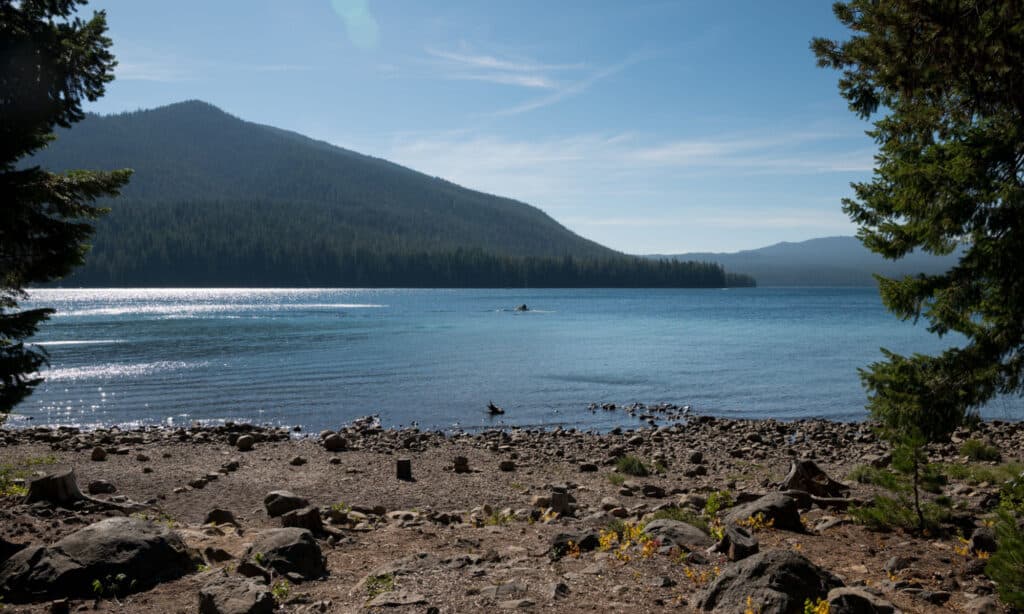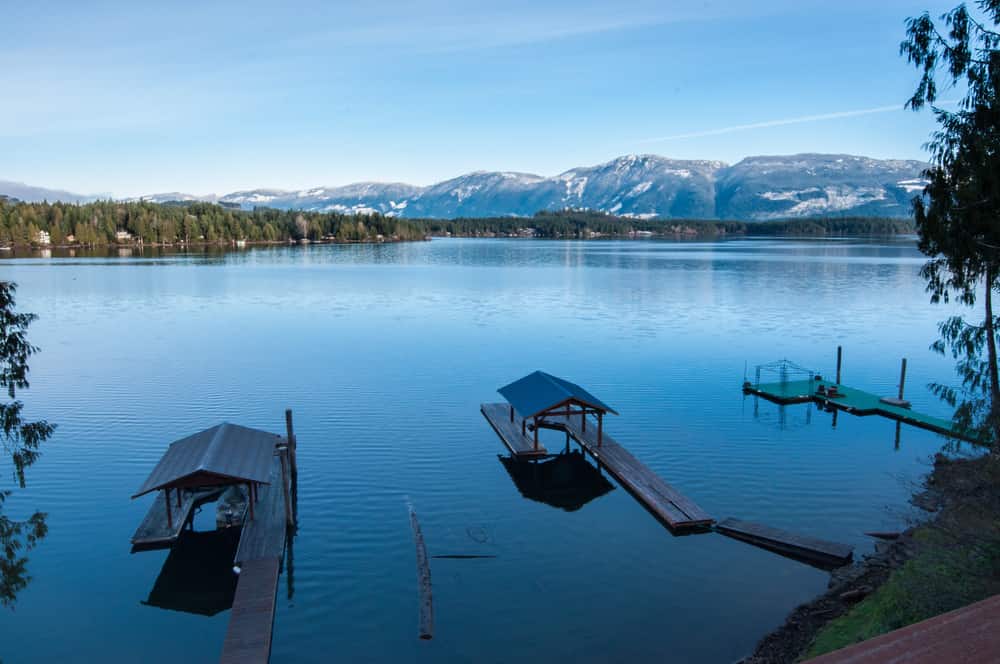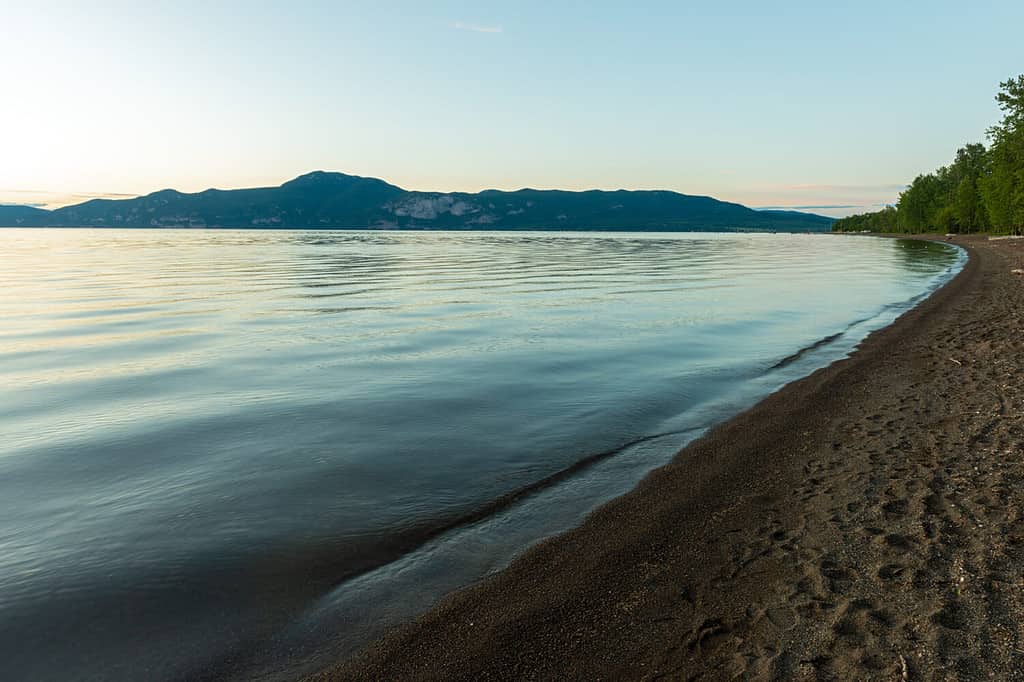Many stunning lakes grace British Columbia’s breathtaking landscapes. They’ve captured the hearts of residents and visitors for generations. Unfortunately, the shadow of water pollution looms large over some of these once-pristine bodies of water. Polluted lakes are a serious problem around the world.
Let’s venture deep into the ten most polluted lakes in British Columbia to uncover the causes and consequences of pollution. This dangerous menace threatens the very ecosystems of these lakes. Come with us as we explore these pressing environmental concerns.
1. Shuswap Lake

Pollutants under the surface are hard to see from a distance but cause damage.
©EB Adventure Photography/Shutterstock.com
Shuswap Lake, nestled within the Southern Interior, grapples with pollution primarily from agricultural runoff and sewage discharge from nearby communities. High levels of nitrogen and phosphorus have infiltrated its waters, fostering the growth of harmful algal blooms that degrade water quality and disrupt the aquatic ecosystem.
The agricultural runoff into Shuswap Lake, laden with fertilizers and chemicals, acts as a potent catalyst for the growth of harmful algal blooms. These blooms render the once-pristine waters unsightly and threaten the health of aquatic life and the overall ecosystem.
As the algae die off, their decomposition consumes oxygen, leading to hypoxic conditions that further endanger fish and other marine organisms. The local economy, deeply entwined with tourism and recreational activities, suffers as water quality deteriorates, impacting local businesses and the livelihoods of those who rely on the now-polluted lake.
2. Okanagan Lake

Invasive species have wreaked havoc on this beautiful lake.
©RLS Photo/Shutterstock.com
Agricultural runoff and unrelenting urban development have taken their toll on Okanagan Lake. Elevated nutrient levels have paved the way for invasive species such as quagga and zebra mussels, posing formidable challenges to managing water quality and imperiling native fish populations.
The intrusion of quagga and zebra mussels into Okanagan Lake represents a devastating ecological invasion. These invasive mollusks multiply rapidly, attaching themselves to various surfaces, including native mussels and water infrastructure, such as pipes and docks.
This disrupts the lake’s delicate balance and poses significant economic burdens through costly maintenance and repairs. Moreover, the increased competition for resources with native species threatens the stability of the entire aquatic food chain, with potentially cascading effects on the health of the lake’s ecosystem.
3. Cultus Lake

High bacteria levels and pollutants plague Cultus Lake.
©Manuela Durson/Shutterstock.com
In the Fraser Valley, Cultus Lake contends with contamination issues from stormwater runoff laden with pollutants, including oil, heavy metals, and pesticides. Heightened bacteria levels have resulted in frequent beach closures at the polluted lake, casting a shadow over the safety of recreational activities.
Stormwater runoff into Cultus Lake carries a menacing cocktail of contaminants, ranging from oil residues to heavy metals like lead and copper. These pollutants not only cloud the lake’s once-clear waters but also pose a direct threat to aquatic life and public health. The elevated bacteria levels have made the lake’s beaches unsafe for swimming, a stark departure from the days when families could frolic in its waters without concern. The economic repercussions reverberate through decreased tourism and a diminished appeal for residents.
4. Harrison Lake

Mercury levels in the fish population of Harrison Lake keep people from fishing.
©Edmund Lowe Photography/Shutterstock.com
Industrial activities and mining operations in the surrounding area have led to heavy metal contamination of Harrison Lake. Metals like lead, cadmium, and mercury have raised concerns regarding fish consumption from the lake, casting a shadow on the local ecosystem and human health.
The industrial footprint around Harrison Lake leaves an indelible mark on its waters. Heavy metals, notably lead, cadmium, and mercury, enter the lake through runoff and leaching from mining sites and industrial facilities. These toxic substances accumulate in fish, rendering them unsafe for human consumption.
The local indigenous communities, who have relied on the lake’s resources for generations, face health risks and a profound loss of cultural traditions tied to fishing. Moreover, the contamination seeps into the broader ecosystem, impacting the entire food web and the lake’s long-term health.
5. Cowichan Lake

Algal blooms damage many parts of the lake.
©karamysh/Shutterstock.com
Cowichan Lake on Vancouver Island faces a dual threat from agricultural runoff and wastewater discharges. Excess nutrients have fueled harmful algal blooms, leading to oxygen depletion and negatively affecting fish habitat and water quality.
Agricultural runoff into Cowichan Lake carries an overabundance of nutrients, including nitrogen and phosphorus, stemming from fertilizers and livestock waste. These excess nutrients have set the stage for harmful algal blooms, creating a visible, noxious green scum on the lake’s surface. As these algae increase, they consume oxygen in the water during decomposition, leading to hypoxic conditions that imperil fish populations. The lake’s water quality suffers, impacting aquatic life and the countless residents and visitors who once enjoyed the lake’s pristine beauty for swimming, boating, and fishing.
6. Sproat Lake

Recreation activities have declined because of pollution concerns.
©jmab10/Shutterstock.com
Forestry activities near Sproat Lake on Vancouver Island have caused sedimentation and reduced water clarity. These changes have profound implications for the lake’s aquatic life, including salmon populations, and have diminished the recreational value of the area.
The impact of forestry activities near Sproat Lake extends beyond the visual disruption of the pristine waters. Clear-cutting and logging can lead to increased sedimentation in the lake, clouding the once-crystal-clear waters and reducing light penetration, affecting the growth of aquatic plants and the health of fish populations. Salmon, in particular, depend on clear, calm waters for their spawning and survival. With declining water clarity, their habitat is threatened, endangering the entire salmon ecosystem. Furthermore, the reduced recreational appeal of the lake affects local tourism and businesses, impacting the community’s economic well-being.
7. Christina Lake

Fertilizers and animal waste find their way to the lake via agricultural runoff.
©Amanda TQ/Shutterstock.com
Agricultural runoff with nutrients has impaired water quality in Christina Lake in the Kootenay region. The excess nutrients have fueled algae growth, impacting the ecosystem and diminishing the lake’s appeal for residents and tourists.
The agricultural runoff into Christina Lake carries excess nutrients like phosphorus and nitrogen from fertilizers and animal waste. These nutrients serve as a banquet for algae, leading to the proliferation of blooms that cloud the once-clear waters. Algal blooms can be unsightly and produce toxins harmful to aquatic life. The lake’s ecosystem is also disrupted as the invasive algae outcompete native species, impacting biodiversity. This water quality degradation has far-reaching consequences, undermining the lake’s appeal for residents and visitors seeking the serene beauty that once defined Christina Lake.
8. Stuart Lake

The mining industry has wreaked havoc on Stuart Lake.
©davidrh/Shutterstock.com
Northern British Columbia’s Stuart Lake bears the brunt of mining activities, releasing heavy metals into its waters. The presence of substances like arsenic and lead has led to water quality advisories and raised concerns about the safety of the lake for recreation and subsistence fishing.
The legacy of mining activities around Stuart Lake casts a dark shadow on its waters. Runoff from mines introduces heavy metals such as arsenic and lead, which not only pose a direct threat to the lake’s water quality but also accumulate in fish, rendering them unsafe for consumption.
Water quality advisories have become necessary, cautioning against swimming and fishing in the lake. Indigenous communities and recreational anglers, who have depended on the lake for sustenance and leisure, face the harsh reality of losing a cherished resource. The enduring environmental impact extends beyond the lake, affecting the broader ecosystem and local communities reliant on the lake’s health.
9. Lake Revelstoke

The disruption of water flow patterns negatively impacts Lake Revelstoke.
©Michelle La/Shutterstock.com
Surrounded by hydroelectric development, Lake Revelstoke has witnessed the disruption of natural water flow patterns, resulting in sedimentation and changes in water levels. These alterations have far-reaching consequences for the lake’s ecosystem, including fish populations and water quality.
Hydroelectric development around Lake Revelstoke has drastically altered the lake’s natural flow patterns. The regulation of water levels and flows has led to sedimentation, as the water’s momentum slows, depositing sediments that cloud the lake’s waters. These changes not only impact the aesthetic appeal of the lake but also threaten its ecosystem. Salmon, which rely on free-flowing rivers and stable water levels for spawning, face new challenges. Additionally, the altered water chemistry due to sedimentation and regulation threatens water quality, impacting the health of aquatic life and the overall ecological balance of the lake.
10. Summit Lake

The lake’s future is uncertain as contaminants take over.
©Fremme/Shutterstock.com
A Call to Action
Summit Lake contends with pollution from nearby mining and industrial activities in the Kootenay region. The presence of heavy metals like copper and zinc has prompted monitoring and restrictions on fishing.
These metals can accumulate in fish, making them unsafe as food sources. Consequently, fishing restrictions have been implemented, impacting the traditional subsistence practices of local communities and recreational anglers alike. The uncertainty surrounding the lake’s future underscores the urgency of addressing pollution and ensuring its long-term ecological health.
In the heart of British Columbia’s stunning landscapes, you’ll find its lakes—once pristine and beloved, now polluted. Our exploration of the ten most polluted lakes in this beautiful province shows a mishmash of environmental problems. Each one has unique causes and serious consequences. From farm runoff and industrial gunk to invasive critters, these lakes show us what can happen when we mess with Mother Nature.
But don’t despair! There’s a silver lining and a call to get moving—a call to deal with the natural causes of pollution. We must cut back on the yucky stuff from farms, put a leash on industrial mess-making, and encourage people to be responsible. Taking care of these incredible natural spots is a team effort, a way to show we’re dedicated to keeping our natural treasures safe.
We want to motivate change and inspire people by illuminating these lakes’ troubles. We imagine a future where British Columbia’s lakes keep wowing us, with crystal-clear waters full of life and ecosystems thriving as they should. Keeping these lakes healthy might be a bumpy road, but it’s worth taking. Together, we can ensure these lakes stay as gorgeous and vibrant as the landscapes they’re part of for generations.
The photo featured at the top of this post is © Elif Bayraktar/Shutterstock.com
Thank you for reading! Have some feedback for us? Contact the AZ Animals editorial team.






